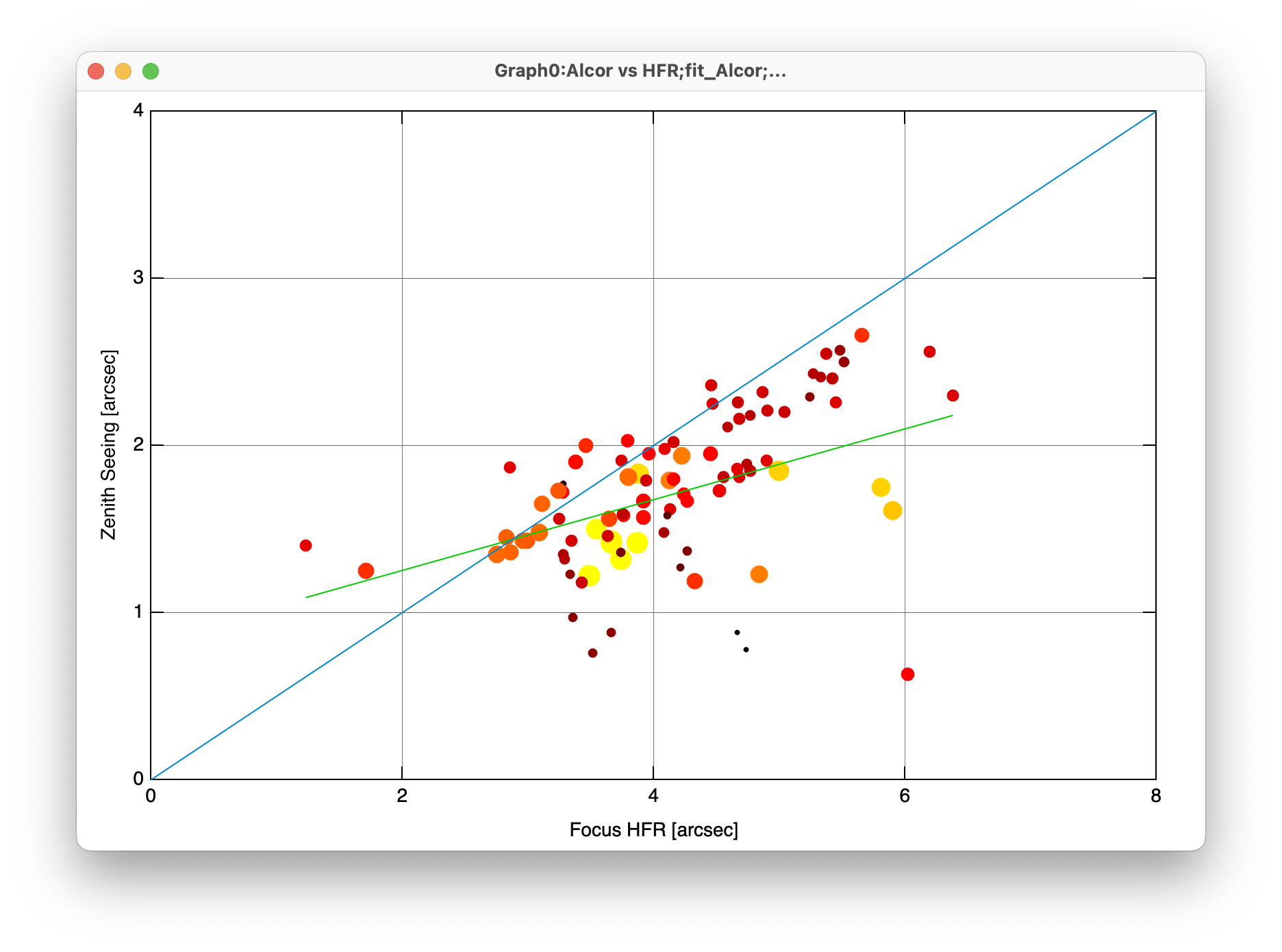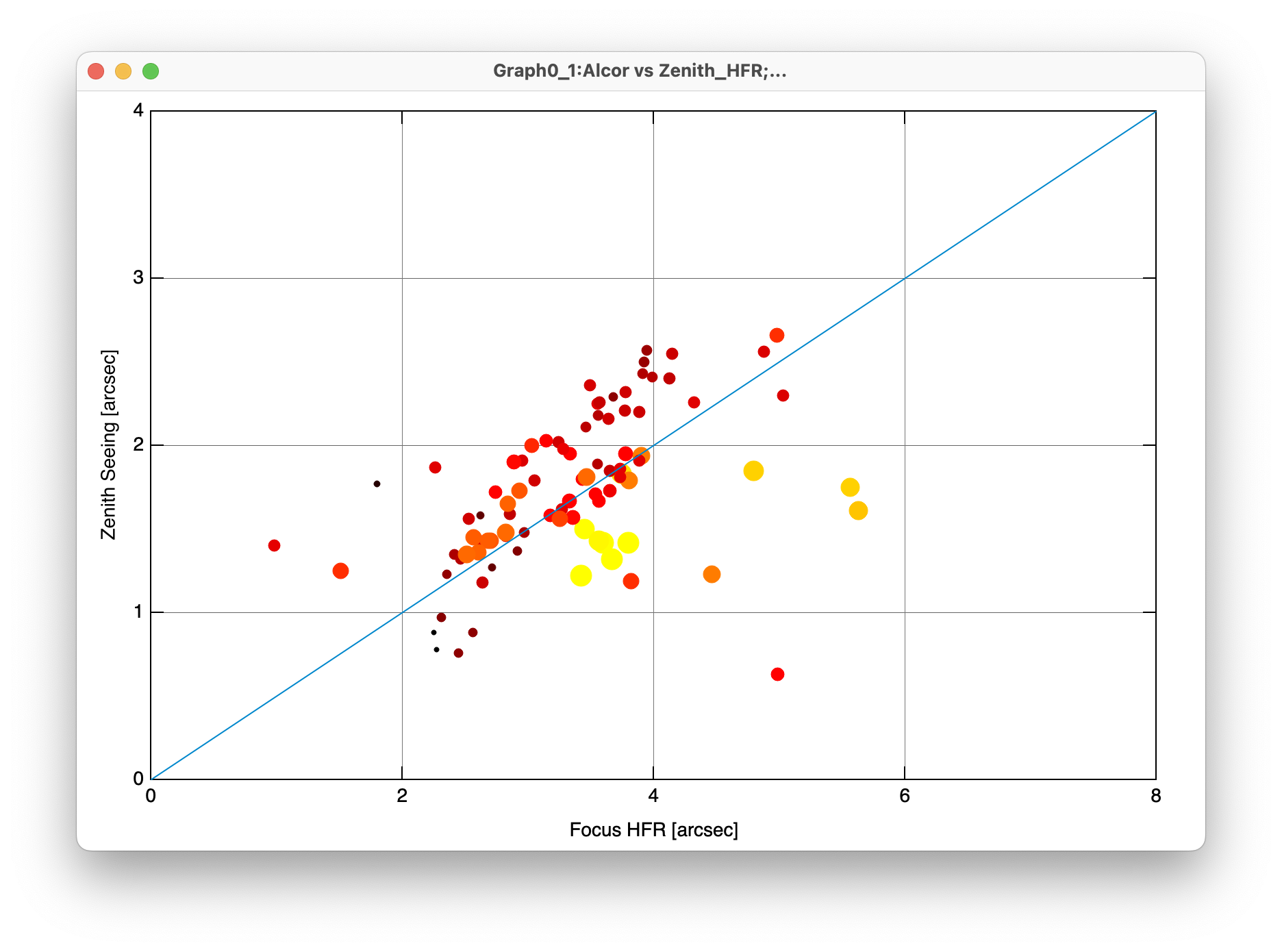INDI Library v2.0.7 is Released (01 Apr 2024)
Bi-monthly release with minor bug fixes and improvements
determining atmospheric 'seeing'
- Ronald Scotti
-
 Topic Author
Topic Author
- Offline
- Elite Member
-

- Posts: 396
- Thank you received: 17
determining atmospheric 'seeing' was created by Ronald Scotti
We are always at the mercy of 'seeing' and trying to determine whether it is worth continuing to image or just call it a night might be helpful. Most of the time we just continue on and will not know how bad the night was until we see the final results. The other piece of information that is showing up in discussions as relevant is the wind data, at some high altitude, in the direction of a particular target. The information that is currently available includes; our location, the target direction (RA and DEC). If the program could access a weather information site (like Windy) and provide the high level winds in that direction, that might give us some indication of the kind of 'seeing' we might expect for the night.
I am just thinking outside the box here for what might be added to the program that could be useful for the users.
Please Log in or Create an account to join the conversation.
Replied by John on topic determining atmospheric 'seeing'
As a *very* rough approximation you could take the FWHM or 2 * HFR of a shortish exposure so its not too "polluted" by guiding / wind, etc issues. So, for example, use the Autofocus FWHM or 2 * HFR result. You can display the focus results in pixels or arc-seconds.
Happy to discuss alternative calculations if anyone is aware of any?
Please Log in or Create an account to join the conversation.
Replied by Massimo on topic determining atmospheric 'seeing'
Please Log in or Create an account to join the conversation.
Replied by alacant on topic determining atmospheric 'seeing'
Hi
PHD2 has a 'guiding assistant' which estimates the seeing in real time and goes on to recommend settings based on the seeing measurements, e.g. for minimum movement required trigger guiding pulses in RA and DEC, camera exposure... These recommendations help prevent -what they call- 'chasing the seeing'.
I wonder if something similar could be made available with the EKOS guider?
Cheers
Please Log in or Create an account to join the conversation.
- Richard Francis
-

- Offline
- Premium Member
-

- Posts: 146
- Thank you received: 16
Replied by Richard Francis on topic determining atmospheric 'seeing'
- It has a fast video camera pointing at Polaris (so no tracking is needed -- the field of view is sufficient that Polaris is always in the frame, if you set the initial alignment right.
- it uses a fast frame rate, the faster the better. Mine is set at 125 fps, but apparently it should be higher. So it needs a high-speed interface. The accompanying software demands a dedicated gigabit ethernet connection, and since you need another one for getting the results out, it ends up being a double-network machine.
- It also needs a fast processor to process all these frames. If I remember well the minimum was some sort of i5 processor (and the software is Windows-only unfortunately -- I had to buy a dedicated machine).
The software analyses the rapid movements of Polaris over 3000 frames then generates a single seeing measure (as well as a flux measure which is also useful as it turns out). It converts the movement into seeing in arcsec, and then makes a further compensation to seeing at the zenith. It works well for me, but it wasn't cheap -- the stuff from Alcor was over 2000 EUR, then add the fast Windows machine and the need for a solid support (so that environmental vibrations, such as wind, don't jiggle the image) -- in my case that was a natural limestone, rough-hewn column (with a nice flat top) installed by our local stonemason, on a 2m concrete foundation.
So the trick is:
(a) generate very rapid frames of a star (and Polaris avoids the need for tracking but is not the only option -- a star close to the imaging subject would be better)
(b) create some software which will analyse the frames and calculate he equivalent seeing.
Cheers,
Richard
Please Log in or Create an account to join the conversation.
Replied by John on topic determining atmospheric 'seeing'
Just out of curiosity how far off is 2 * HFR from Focus in comparison with the Cyclope?
Please Log in or Create an account to join the conversation.
- Richard Francis
-

- Offline
- Premium Member
-

- Posts: 146
- Thank you received: 16
Replied by Richard Francis on topic determining atmospheric 'seeing'
I found
2024-02-03 01:35 HFR = 3.28, zenith seeing = 1.77"
2024-02-13 21:28 HFR = 1.23, zenith seeing = 1.4"
This is an interesting comparison and I will try to do a more thorough job under a range of conditions.
But we need to be clear that my target's were in the Orion area, on the opposite side of the sky from Polaris, so the calculated zenith seeing is never more then an indication of the quality of the night (and I've seen it go up to 5 or so, normally when it's windy).
Cheers,
Richard
Please Log in or Create an account to join the conversation.
- Richard Francis
-

- Offline
- Premium Member
-

- Posts: 146
- Thank you received: 16
Replied by Richard Francis on topic determining atmospheric 'seeing'
The points are weighted by altitude from 76 to 17, indicated by colour (yellow being highest and black lowest) and spot size. I also used them as weights in the green linear fit, but it didn't make much difference compared to the unweighted fit. The blue line has slope 0.5 and represents the HFR = twice seeing rule. It probably needs better quality control and more data.
Attachments:
Please Log in or Create an account to join the conversation.
Replied by John on topic determining atmospheric 'seeing'
Thanks for sharing that!
Did you compensate the HFR by altitude for comparison with the zenith seeing coming out of the Cyclope? Or alternatively, can you get the Cyclope seeing unadjusted for zenith, in order to compare with 2 * HFR?
Please Log in or Create an account to join the conversation.
- Richard Francis
-

- Offline
- Premium Member
-

- Posts: 146
- Thank you received: 16
Replied by Richard Francis on topic determining atmospheric 'seeing'
I didn't do any fancy processing. The HFR is as it is reported in the focus logs, and zenith seeing is from the Alcor logs.
I think of your 2 alternatives the first would be more reasonable, in that both quantities would have been through the same transposition. In the other case I'd have to back-convert the Alcor values (the Polaris seeing is not in the log) and then we still end up with estimates on (usually) opposite sides of the sky.
I'll have a look in te Alcor documentation to find the conversion they use.
Please Log in or Create an account to join the conversation.
- Richard Francis
-

- Offline
- Premium Member
-

- Posts: 146
- Thank you received: 16
Replied by Richard Francis on topic determining atmospheric 'seeing'
Attachments:
Please Log in or Create an account to join the conversation.
Replied by John on topic determining atmospheric 'seeing'
Seems like 2 * Focus HFR in arc-secs isn't a bad proxy for the seeing!
Please Log in or Create an account to join the conversation.


